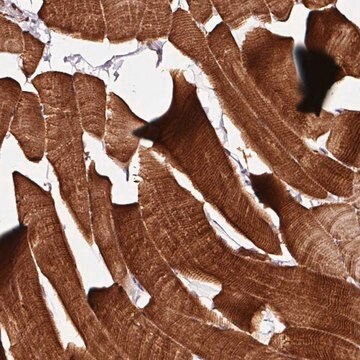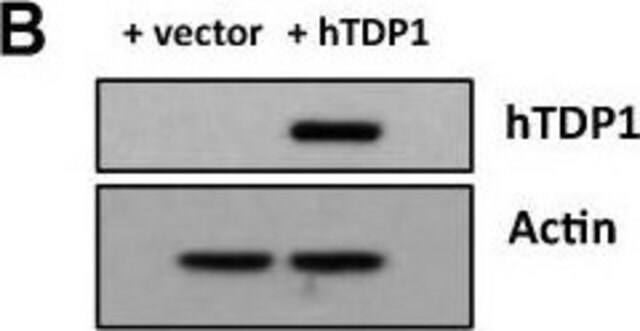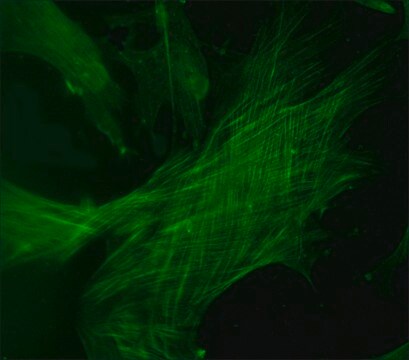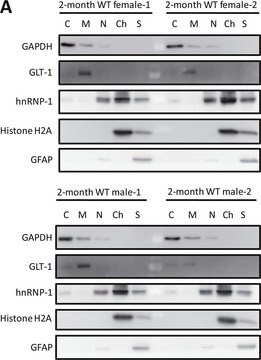추천 제품
생물학적 소스
mouse
Quality Level
결합
unconjugated
항체 형태
ascites fluid
항체 생산 유형
primary antibodies
클론
TM311, monoclonal
분자량
antigen 36-39 kDa
포함
15 mM sodium azide
종 반응성
pig, chicken, bovine, rabbit, mouse, hamster, rat, human
기술
immunoprecipitation (IP): suitable
indirect ELISA: suitable
indirect immunofluorescence: 1:400 using chicken fibroblasts
microarray: suitable
western blot: suitable using human tissue and chicken gizzard extracts
동형
IgG1
UniProt 수납 번호
배송 상태
dry ice
저장 온도
−20°C
타겟 번역 후 변형
unmodified
유전자 정보
bovine ... TPM1(281544)
chicken ... TPM1(396366)
human ... TPM1(7168)
mouse ... Tpm1(22003)
rat ... Tpm1(24851)
일반 설명
Monoclonal Anti-Tropomyosin (mouse IgG1 isotype) is derived from the hybridoma produced by the fusion of mouse myeloma cells and splenocytes from an immunized mouse. Tropomyosin is a rigid rod-shaped protein closely associated with actin filaments. Non-muscle forms of tropomyosin have been identified in a wide range of cell types. Tropomyosin is made of two α helical polypeptide chains.
면역원
chicken gizzard tropomyosin.
애플리케이션
Monoclonal Anti-Tropomyosin has been used:
- in immunofluorescent labelling
- in immunohistochemistry
- in western blotting
- in immunoblotting
Mouse monoclonal clone TM311 anti-Tropomyosin antibody is used to tag tropomyosin for detection and quantitation by immunocytochemical and immunohistochemical (IHC) techniques such as immunoblotting, immunoprecipitation, and immunofluorescence. It is used as a probe to determine the presence and roles of tropomyosin in cytoskeletal structures.
생화학적/생리학적 작용
Tropomyosin together with troponin, regulate the binding of myosin to actin. Tropomyosin is a dimeric coiled-coil protein forming continuous polymers along the myosin-binding groove of actin. Various tropomyosin isoforms help to confer structure and function to actins in the cytoskeleton and in striated muscle function.
면책조항
Unless otherwise stated in our catalog or other company documentation accompanying the product(s), our products are intended for research use only and are not to be used for any other purpose, which includes but is not limited to, unauthorized commercial uses, in vitro diagnostic uses, ex vivo or in vivo therapeutic uses or any type of consumption or application to humans or animals.
적합한 제품을 찾을 수 없으신가요?
당사의 제품 선택기 도구.을(를) 시도해 보세요.
Storage Class Code
10 - Combustible liquids
WGK
nwg
Flash Point (°F)
Not applicable
Flash Point (°C)
Not applicable
Activation of MAP kinases and phosphorylation of caldesmon in canine colonic smooth muscle.
Gerthoffer W T, et al.
The Journal of Physiology, 495(3), 597-609 (1996)
Iman Jalilian et al.
PloS one, 10(5), e0126214-e0126214 (2015-05-16)
The actin cytoskeleton is the primary polymer system within cells responsible for regulating cellular stiffness. While various actin binding proteins regulate the organization and dynamics of the actin cytoskeleton, the proteins responsible for regulating the mechanical properties of cells are
Non-canonical Wnt signaling enhances differentiation of Sca1+/c-kit+ adipose-derived murine stromal vascular cells into spontaneously beating cardiac myocytes
Palpant N J, et al.
Journal of Molecular and Cellular Cardiology, 43(3), 362-370 (2007)
Vertebrate tropomyosin: distribution, properties and function
Perry, S Victor
Journal of Muscle Research and Cell Motility, 22(1), 5-49 (2001)
J Boyd et al.
Proceedings of the National Academy of Sciences of the United States of America, 92(25), 11534-11538 (1995-12-05)
Variants of chemically immortalized Syrian hamster embryo cells that had either retained (supB+) or lost (supB-) the ability to suppress tumorigenicity when hybridized with a fibrosarcoma cell line were subcloned. Both supB cell types are nontumorigenic; however, the supB- but
자사의 과학자팀은 생명 과학, 재료 과학, 화학 합성, 크로마토그래피, 분석 및 기타 많은 영역을 포함한 모든 과학 분야에 경험이 있습니다..
고객지원팀으로 연락바랍니다.








